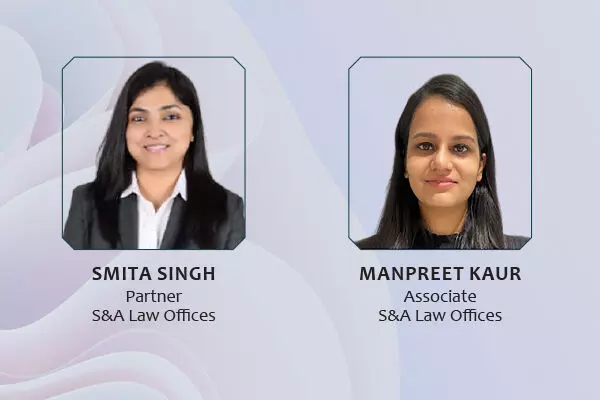- Home
- News
- Articles+
- Aerospace
- Artificial Intelligence
- Agriculture
- Alternate Dispute Resolution
- Arbitration & Mediation
- Banking and Finance
- Bankruptcy
- Book Review
- Bribery & Corruption
- Commercial Litigation
- Competition Law
- Conference Reports
- Consumer Products
- Contract
- Corporate Governance
- Corporate Law
- Covid-19
- Cryptocurrency
- Cybersecurity
- Data Protection
- Defence
- Digital Economy
- E-commerce
- Employment Law
- Energy and Natural Resources
- Entertainment and Sports Law
- Environmental Law
- Environmental, Social, and Governance
- Foreign Direct Investment
- Food and Beverage
- Gaming
- Health Care
- IBC Diaries
- In Focus
- Inclusion & Diversity
- Insurance Law
- Intellectual Property
- International Law
- IP & Tech Era
- Know the Law
- Labour Laws
- Law & Policy and Regulation
- Litigation
- Litigation Funding
- Manufacturing
- Mergers & Acquisitions
- NFTs
- Privacy
- Private Equity
- Project Finance
- Real Estate
- Risk and Compliance
- Student Corner
- Take On Board
- Tax
- Technology Media and Telecom
- Tributes
- Viewpoint
- Zoom In
- Law Firms
- In-House
- Rankings
- E-Magazine
- Legal Era TV
- Events
- Middle East
- Africa
- News
- Articles
- Aerospace
- Artificial Intelligence
- Agriculture
- Alternate Dispute Resolution
- Arbitration & Mediation
- Banking and Finance
- Bankruptcy
- Book Review
- Bribery & Corruption
- Commercial Litigation
- Competition Law
- Conference Reports
- Consumer Products
- Contract
- Corporate Governance
- Corporate Law
- Covid-19
- Cryptocurrency
- Cybersecurity
- Data Protection
- Defence
- Digital Economy
- E-commerce
- Employment Law
- Energy and Natural Resources
- Entertainment and Sports Law
- Environmental Law
- Environmental, Social, and Governance
- Foreign Direct Investment
- Food and Beverage
- Gaming
- Health Care
- IBC Diaries
- In Focus
- Inclusion & Diversity
- Insurance Law
- Intellectual Property
- International Law
- IP & Tech Era
- Know the Law
- Labour Laws
- Law & Policy and Regulation
- Litigation
- Litigation Funding
- Manufacturing
- Mergers & Acquisitions
- NFTs
- Privacy
- Private Equity
- Project Finance
- Real Estate
- Risk and Compliance
- Student Corner
- Take On Board
- Tax
- Technology Media and Telecom
- Tributes
- Viewpoint
- Zoom In
- Law Firms
- In-House
- Rankings
- E-Magazine
- Legal Era TV
- Events
- Middle East
- Africa

Classification disputes triggered by the complexities in the GST regime
Classification disputes triggered by the complexities in the GST regime

CLASSIFICATION DISPUTES TRIGGERED BY THE COMPLEXITIES IN THE GST REGIME The Goods and Services Tax (‘GST’) Law completed five (5) years in July this year, however, many issues are yet to be settled and some issues that were presumed to be settled are now unsettled. One of the major areas of controversies is the classification of goods and services. Classification disputes have been...
To Read the Full Story, Subscribe to Legal Era News
Access Exclusive Legal Era Stories, Editorial Insights, and Expert Opinion.
Already a subscriber? Sign in Now
CLASSIFICATION DISPUTES TRIGGERED BY THE COMPLEXITIES IN THE GST REGIME
The Goods and Services Tax (‘GST’) Law completed five (5) years in July this year, however, many issues are yet to be settled and some issues that were presumed to be settled are now unsettled. One of the major areas of controversies is the classification of goods and services. Classification disputes have been in vogue since time immemorial, and in the present regime, Authority for Advance Rulings (‘AARs’) have misbalanced many established positions by pronouncing contradictory rulings, thus adding to the woes of the industry.
Though Harmonized System of Nomenclature (HSN) classification has been adopted from internationally accepted commodity description and coding system developed by the World Customs Organization, nevertheless, it does leave doubt around the interpretation of relevant headings and Chapters in many cases. Because of such ambiguity and change in stand by authorities, industry has witnessed interesting rulings around the classification of goods under GST, specifically related to consumables.

In the case of Vadilal1, the assessee failed to convince the Appellate AAR (‘AAAR’) that a parantha is nothing but unleavened Indian bread. Or that, as wheat flour is its primary ingredient, it bears a close resemblance to “Roti” and “Chapatti” and hence should be liable to GST at 5%. In this case, AAAR held that Frozen Parathas have a wheat composition of 36% to 62% unlike Roti or Chapatti, which contains only wheat and water. Moreover, it was highlighted that Parathas requires preheating of 3-4 minutes before consumption, whereas roti and chapatti do not need the same. Thus, it has been held that Parathas cannot be treated as or covered under the category of Roti or Chapatti; hence liable to GST at 18% under the category ‘goods not specified elsewhere’. The ruling in the Vadilal case was pronounced in complete contradiction to an earlier ruling given by the Maharashtra AAR in the Signature International Foods case2 wherein it was held that various types of Indian bread are called by different names, however, the classification should not merely be guided by nomenclature. Accordingly, Parathas were classified as Roti - chargeable to GST at 5%.
The Roti versus Parathas debate is one of the main classification disputes arisen under the GST regime. Another such dispute handled by Tamil Nadu AAR3 with interesting observation was related to the classification of ready-to-cook Dosa, Idli, Porridge Mix, etc. sold in powdered form. While making the application, the applicant relied upon the Gujarat AAR4 in the case of Dipak Kumar Kantilal Chotai wherein it was held that mixed flour for Khaman, Idli, Gota, Pudla, Dosa is liable to GST at the rate of 5%. However, Tamil Nadu AAR in the case of Raja Rasesh, held totally a contrary view and drew a distinction between branded mixes and wet batter and held that the mixes for Dosa and Idli are packed and sold as mixes which are to be later mixed with water/curd to make it as batter and the product sold is powder and not batter and will attract GST at 18%.
These divergent rulings by AARs are rather acting as fuel to classification disputes by pronouncing contradictory rulings than settling the issue. Be it the classification of ‘Fryums’ under ‘residual entry for food items’ to be chargeable to GST at 18% and not as ‘Papad’ chargeable to GST at 5%5 or classifying ‘Flavoured Milk’ separate from the milk (which is an exempt good) and taxing the same at 12%6. The tax authorities have shared varied views on the classification of goods especially food items and have a tendency to classify goods at higher tax rate brackets.
Further, another side of the coin is that businesses also tend to take advantage of ambiguities around classification rulings by AARs. Many businesses try their luck by resorting to AAR to categorise their products at lower rates despite having clear classifications in the earlier regime. One such case is of Dabur odomos7 , which is used as a mosquito repellent for years and was supplied by Dabur under Chapter 38.08 i.e., ‘Repellents for insects such as flies, mosquito’ in the pre-GST regime. However, with the introduction of GST, Dabur filed AAR to confirm the classification of odomos as ‘medicament’ chargeable to GST at 12%. Uttar Pradesh AAR, however, rejected the contentions and held that the statute is very clear as far as the classification of items intended to ‘repel pests’ is concerned and held that odomos being a pest repellent shall be classified under Chapter 38.08 i.e. ‘Repellents for insects such as flies, mosquito’ and be chargeable to GST at 18%.
It is needless to say that as per rules of classification, the principles that needs to be assessed range from basic character, nature, and ordinary meaning, technical specifications, end use, understanding in trade parlance, etc. Needless to say, these endless classification disputes about the complex classification norms, as also the multiplicity of slabs, varying interpretations by both government and business, and contrary advance rulings, which many times differ from state to state, are not helping to set the matter at rest.
The government intends to formulate a plan for introducing a dispute resolution, which would streamline and ensure uniform applicability of classification across the nation and not a separate classification of same goods in different states. Moreover, reducing the tax slabs and rates could also be a potential solution to classification disputes, which recently many government officials have indicated as the intended move. Nevertheless, until tax rates are amended to fewer slabs, or a central authority for dispute resolution is set up, these classifications disputes will continue to be pain points of the industry.
2. Signature international Foods India Private Limited , GST AAR Maharashtra, GST-ARA-29/2018-19/B-91 dated August 20, 2018
3. Raja Rasesh, GST AAR Tamil Nadu, Order No. 24/ARA/2021 dated June 18, 2021
4. Dipakkumar Kantilal Chotai, GST AAR Gujarat, Advance Ruling No. GUJ/GAAR/R/43/2020 dated July 30, 2020
5. Alisha Foods, GST AAAR Madhya Pradesh, Advance Ruling No. MP/AAAR/02/2020/34 dated August 27, 2020
6. Gujarat Co-operative Milk Marketing Federation Ltd, GST AAAR Gujarat, Advance Ruling No. GUJ/AAAR/APPEAL/2022/17 dated August 22, 2022
7. Dabur India Ltd., GST AAR Uttar Pradesh, Order No. 25 dated February 20, 2019


